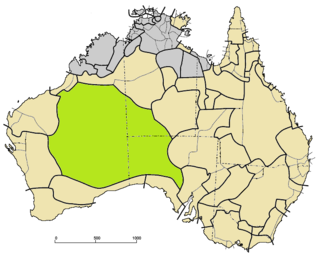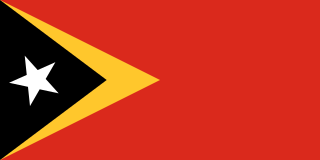Related Research Articles
Australian English is the set of varieties of the English language native to Australia. Although English has no official status in the Constitution, Australian English is the country's national and de facto official language as it is the first language of the majority of the population.

Oceania is a geographic region that includes Australasia, Melanesia, Micronesia and Polynesia. Spanning the eastern and western hemispheres, Oceania has a land area of 8,525,989 square kilometres (3,291,903 sq mi) and a population of over 47 million. Situated in the southeast of the Asia-Pacific region, Oceania, when compared to continental regions, is the smallest in land area and the second smallest in population after Antarctica.
In linguistics, voicelessness is the property of sounds being pronounced without the larynx vibrating. Phonologically, it is a type of phonation, which contrasts with other states of the larynx, but some object that the word phonation implies voicing and that voicelessness is the lack of phonation.
In law and government, de facto describes practices that exist in reality, even though they are not officially recognized by laws. It is commonly used to refer to what happens in practice, in contrast with de jure, which refers to things that happen according to law.
The demography of Australia covers basic statistics, most populous cities, ethnicity and religion. The population of Australia is estimated to be 25,698,300 as of 4 May 2020. Australia is the 52nd most populous country in the world and the most populous Oceanian country. Its population is concentrated mainly in urban areas and is expected to exceed 28 million by 2030.

The Australian Aboriginal languages consist of around 290–363 languages belonging to an estimated 28 language families and isolates, spoken by Aboriginal Australians of mainland Australia and a few nearby islands. The relationships between these languages are not clear at present. Despite this uncertainty, the Indigenous Australian languages are collectively covered by the technical term "Australian languages", or the "Australian family".

The Kimberley is the northernmost of the nine regions of Western Australia. It is bordered on the west by the Indian Ocean, on the north by the Timor Sea, on the south by the Great Sandy and Tanami deserts in the region of the Pilbara, and on the east by the Northern Territory.

The Pama–Nyungan languages are the most widespread family of Australian Aboriginal languages, containing perhaps 300 languages. The name "Pama–Nyungan" is derived from the names of the two most widely separated groups, the Pama languages of the northeast and the Nyungan languages of the southwest. The words pama and nyunga mean "man" in their respective languages.

Over 2 billion people speak English, making English the largest language by number of speakers, and the third largest language by number of native speakers. With 300 million native speakers, the United States of America is the largest English-speaking country. As pictured in the pie graph below, most native speakers of English are Americans.

Aboriginal Australians are the various Indigenous peoples of the Australian mainland and many of its islands, such as Tasmania, Fraser Island, Hinchinbrook Island, the Tiwi Islands and Groote Eylandt, but excluding the Torres Strait Islands.

The Western Desert language, or Wati, is a dialect cluster of Australian Aboriginal languages in the Pama–Nyungan family.
Although Australia has no official languages, English has been entrenched as the de facto national language since European settlement. Australian English is a major variety of the language with a distinctive pronunciation and lexicon, and differs slightly from other varieties of English in grammar and spelling. General Australian serves as the standard dialect.

Australia, officially the Commonwealth of Australia, is a sovereign country comprising the mainland of the Australian continent, the island of Tasmania, and numerous smaller islands. It is the largest country in Oceania and the world's sixth-largest country by total area. The population of 26 million is highly urbanised and heavily concentrated on the eastern seaboard. Australia's capital is Canberra, and its largest city is Sydney. The country's other major metropolitan areas are Melbourne, Brisbane, Perth, and Adelaide.

English is a West Germanic language that was first spoken in early medieval England and eventually became a global lingua franca. It is named after the Angles, one of the Germanic tribes that migrated to the area of Great Britain that later took their name, England. Both names derive from Anglia, a peninsula in the Baltic Sea. English is closely related to Frisian and Low Saxon, and its vocabulary has been significantly influenced by other Germanic languages, particularly Norse, and to a greater extent Latin and French.

Australians are people associated with the country of Australia, usually holding Australian citizenship. Australia is a multicultural society and has the world's eighth-largest immigrant population, with immigrants accounting for 30 percent of the population in 2019.
Indigenous Australians are people who are descended from groups that lived in Australia and surrounding islands before British colonisation. They include the Aboriginal and Torres Strait Islander peoples of Australia. The term Aboriginal and Torres Strait Islander people is preferred by many; First Nations of Australia, First Peoples of Australia and First Australians are also increasingly common terms.

East Timor or Timor-Leste, officially the Democratic Republic of Timor-Leste, is a country in Southeast Asia. It comprises the eastern half of the island of Timor, the nearby islands of Atauro and Jaco, and Oecusse, an exclave on the northwestern side of the island surrounded by Indonesian West Timor. Australia is the country's southern neighbour, separated by the Timor Sea. The country's size is about 15,007 km2.

New Guinea is a large island separated by the shallow Torres Strait from the rest of the Australian continent. It is the world's second-largest island, after Greenland, covering a land area of 785,753 km2 (303,381 sq mi), and the largest island wholly or partly within the Southern Hemisphere and Oceania.

Bang Ramat is one of the six khwaengs (subdistricts) of Taling Chan District in Bangkok's Thonburi side. Bang Ramat contained 23 administrative villages.
References
- ↑ Y197 Angkula at the Australian Indigenous Languages Database, Australian Institute of Aboriginal and Torres Strait Islander Studies
| This Australian Aboriginal languages-related article is a stub. You can help Wikipedia by expanding it. |